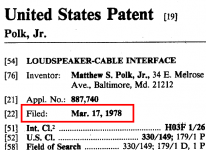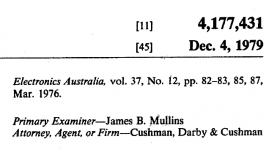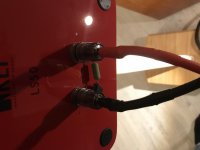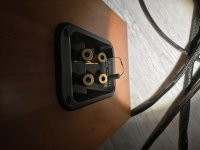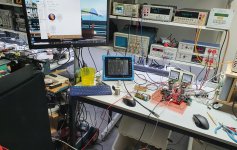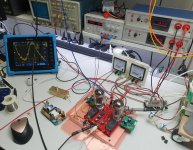Gobel + WADAX + CH Precision + A/V RoomService | Stereophile.com
So here we have a silly expensive system ($70k for a music server!) with JC1+ power amps but speaker cable costing more than the power amps. Can't help wondering if they had intended to use the $93k CH precision power amp and it broke/they sold it so put in what they had.
I can personally think of better ways to spend half a million, but I'm not a dentist 😀
Had the guys at one show trying to tell me my system sounded flat because I hadn’t used £1000 speaker cables. I made my own using 5 mm multi strand copper. With the plastic insulation each cable is about 10 mm in diameter and then both to get pulled through a woven nylon/poly sheath. Gold plated spades both ends, all trimmed and finished off beautifully with heat shrink and clear RTV to make sure nothing comes undone.
The cables will happily do 40 or 50 amps and cost me about £80 in materials to make.
Inductance and capacitance? Who gives a ****. My amps are stable with any.
I understand that the impedance of a driver changes with excursion, and you can call that impedance modulation, sure. And it does cause distortion, yes, so if you can limit it, you get less distortion. Dixit Purifi.
What I don't get is why that would be different with voltage drive or with current drive. What muddles the waters is the tendency to regard voltage and current as if they were two different independent quantities. They are not, they are intimately connected through the impedance.
The suggestion is there that if you do current drive, the impedance modulation doesn't matter because the current will be the same no matter the excursion. But that disregards that in this case, the voltage follows the modulation and is distorted.
How that effects the actual manifestation of the distortion, whether that is the same or different in the two cases, is above my paygrade.
Jan
What I don't get is why that would be different with voltage drive or with current drive. What muddles the waters is the tendency to regard voltage and current as if they were two different independent quantities. They are not, they are intimately connected through the impedance.
The suggestion is there that if you do current drive, the impedance modulation doesn't matter because the current will be the same no matter the excursion. But that disregards that in this case, the voltage follows the modulation and is distorted.
How that effects the actual manifestation of the distortion, whether that is the same or different in the two cases, is above my paygrade.
Jan
Had the guys at one show trying to tell me my system sounded flat because I hadn’t used £1000 speaker cables. I made my own using 5 mm multi strand copper.
You should have said that they were priceless prototypes and would sell for £10,000 if you marketed them as they had had a total electron replacement from a block of gold.
Bonsai you might as well terminate them at the far (speaker) end, anyway. The cost is tiny, the benefit exceeds the cost, and the basic idea doesn't contradict conventional science.
That's in the last paragraph on page 4 of this article written in 1980 . I've attached Matthew Polk's patent, below
_
After a period of confusion, Matt Polk and I realized independently that the lack of a characteristic termination was causing the problem. Polk developed and patented a "damper" consisting of a .047uF capacitor and 6 ohm resistor in series placed across the loudspeaker, while I used the same network but with .1uF and 5 ohms. The results of this network are seen in Fig. 8 where the resonance in the pulsed waveform is damped out, restoring stability
That's in the last paragraph on page 4 of this article written in 1980 . I've attached Matthew Polk's patent, below
_
Attachments
. The cost is tiny, the benefit exceeds the cost, and the basic idea doesn't contradict conventional science.
You might have just summoned JN as well 😀
Hi Jan,
Not even current drive can cure a changing induction, F = B*I*L.
And what about doppler IM modulation even if the induction would remain stable?
Better to stick to ESL’s who don’t have all these anomalies.
So how’s your direct drive high voltage amp in development for this purpose ?
Hans
Not even current drive can cure a changing induction, F = B*I*L.
And what about doppler IM modulation even if the induction would remain stable?
Better to stick to ESL’s who don’t have all these anomalies.
So how’s your direct drive high voltage amp in development for this purpose ?
Hans
Isn’t that exactly what Cyril Bateman advised when trying to find the cause why Amps blew up with certain cables with a very low Zo.Bonsai you might as well terminate them at the far (speaker) end, anyway. The cost is tiny, the benefit exceeds the cost, and the basic idea doesn't contradict conventional science.
That's in the last paragraph on page 4 of this article written in 1980 . I've attached Matthew Polk's patent, below
_
A simple 100R resistor, eventualy in series with a cap cured this problem.
I don’t see why a patent should be granted for terminating a transmission line.
https://www.waynekirkwood.com/images/pdf/Cyril_Bateman/Bateman_Speaker_Amp_Interaction.pdf
Hans
Isn’t that exactly what Cyril Bateman advised when trying to find the cause why Amps blew up with certain cables with a very low Zo.
Probably so -- it's just that Bateman's unpublished work cites magazine articles published in 2002, which means he wrote it at least 24 years after Polk filed for a patent. If you're really upset about the patent, call up the examiner (James B. Mullins) and give him an earful. He allowed it in 1979, a mere forty two years ago, I'm sure he recalls the entire episode in great detail.
_
Attachments
Bonsai you might as well terminate them at the far (speaker) end, anyway. The cost is tiny, the benefit exceeds the cost, and the basic idea doesn't contradict conventional science.
That's in the last paragraph on page 4 of this article written in 1980 . I've attached Matthew Polk's patent, below
_
Funny you should say that. They’re already terminated but not optimized. I used 8.2 Ohms and 0.1 uF.
Thanks for the article - I’ll need to digest that.
(I was planning to feed a 1-2 kHz square wave at say half a volt and then look at the response at the speaker end and trim the damper network as required. )
Attachments
Hi Jan,
[..]
Better to stick to ESL’s who don’t have all these anomalies.
So how’s your direct drive high voltage amp in development for this purpose ?
Hans
I actually had the prototype play (one side of the speaker only) Cassandra Wilson last week! Sounded not bad, even with half a speaker (only one diaphragm driven)! But today when trying to order additional medical grade 5kV isolated DC-DC converters from Powerbox, price had gone up 20% and delivery times quotes as 'we'll do our best for you Mr. Didden!'. Not promising.
Jan
Attachments
Crikey, I think I have seen something resembling an Amplifier stabilising output Zobel before:

Here 10R (not Bonsai's 8.2R) plus 0.1uF in a Rotel RA-931. But an inexact science given huge variations in loudspeakers. 🙂
As self-appointed Forum Expert in Partial Differential Equations. I was examining my friend Mr. Joe Rasmussen's theories about the relative merits of Current and Voltage drive.
I have been always clear that Ohm's Law was the basis of all matters electrical. A Child of Ten knows this. V = IR for the Layman. Where V, I and R are Reals in D.C analysis.
Some people have exaggerated the Matter to include the Complex Impedance Z in A.C analysis. I myself naturally include the Complex Numbers along with the Reals. V and I, too, can lurch into the Complex Plane for all I care. All grist to the Mill to me.
Where I have got to so far. 😎
V = IZ - F(s) where F(s) is a non-linear correction (Distortion) based on A.C voicecoil displacement (s) within the magnet gap.

Really, upon Partial Differentiating, I see no reason to think Volts (V) are distinct from Amps (I). Constants go to Zero. That's it. You are left with is F(s) which is constant distortion. We watch the Hamlet Design with Interest. I think it'll sound the same as everything else. Distorted. My advice is to buy headphones, like Apple EarBuds. Work much better. Millions of Apple customers can't be wrong. Less displacement, you see. 😀
Here 10R (not Bonsai's 8.2R) plus 0.1uF in a Rotel RA-931. But an inexact science given huge variations in loudspeakers. 🙂
As self-appointed Forum Expert in Partial Differential Equations. I was examining my friend Mr. Joe Rasmussen's theories about the relative merits of Current and Voltage drive.
I have been always clear that Ohm's Law was the basis of all matters electrical. A Child of Ten knows this. V = IR for the Layman. Where V, I and R are Reals in D.C analysis.
Some people have exaggerated the Matter to include the Complex Impedance Z in A.C analysis. I myself naturally include the Complex Numbers along with the Reals. V and I, too, can lurch into the Complex Plane for all I care. All grist to the Mill to me.
Where I have got to so far. 😎
V = IZ - F(s) where F(s) is a non-linear correction (Distortion) based on A.C voicecoil displacement (s) within the magnet gap.

Really, upon Partial Differentiating, I see no reason to think Volts (V) are distinct from Amps (I). Constants go to Zero. That's it. You are left with is F(s) which is constant distortion. We watch the Hamlet Design with Interest. I think it'll sound the same as everything else. Distorted. My advice is to buy headphones, like Apple EarBuds. Work much better. Millions of Apple customers can't be wrong. Less displacement, you see. 😀
Last edited:
I can personally think of better ways to spend half a million, but I'm not a dentist 😀
Down payment on a house? I think that would cover 20% around here. Similar/worse in London, methinks.
(Insert tears of a wannabe first home buyer)
V = IZ - F(s) where F(s) is a non-linear correction (Distortion) based on A.C voicecoil displacement (s) within the magnet gap.
I think this is where confusion springs from. It always is V = I*Z . Not more, not less. It's not just a good idea, it's the law 😎
If there is distortion, call it F(s), that modifies either Z, or V or I (or any combination), in such a way that V = I*Z still holds. Always. At any instance in time, the product of I and Z will be V, either as reals or complex.
A Nobel awaits whoever can break that.
Jan
Last edited:
Down payment on a house? I think that would cover 20% around here. Similar/worse in London, methinks.
(Insert tears of a wannabe first home buyer)
Derfy,
I bought my 2 story brick house in a good school district and neighborhood for $40,000.00. An old friend bought a similar house with about the same amount of land in the Washington DC area for $980,000 around the same time.
Taxes from the county, borough and school district are all based on the assessed value. Interestingly the county and borough assess at $28,000 and the school district $32,000.
The teardown house behind me assessed at $85,000 and sold for $17,500.
One secret to home buying is to look carefully around where you would like to live and then look up the real estate records of those properties. This has worked well for me. Pretty much buying and renovating has allowed the actual value to go up around five times what I paid.
I did note on my block there is a bit of land only that has annual taxes of $1.89 all unpaid for the years shown. However as the last title transfer was in 1930, I don't think the owner of record is still alive.
My understanding of some London real estate is that you might own the house, but you lease the land!
Last edited:
Probably so -- it's just that Bateman's unpublished work cites magazine articles published in 2002, which means he wrote it at least 24 years after Polk filed for a patent. If you're really upset about the patent, call up the examiner (James B. Mullins) and give him an earful. He allowed it in 1979, a mere forty two years ago, I'm sure he recalls the entire episode in great detail.
_
You’re well documented, thx.
Hans
(Insert tears of a wannabe first home buyer)
Just as bad when you fall off the ladder due to divorce.
Derfy,
My understanding of some London real estate is that you might own the house, but you lease the land!
Duke of Westminster(s) has done very well out of that, owning 300 acres of prime land in London, which was probably mainly swamp when they were originally gained by marriage.
- Home
- Member Areas
- The Lounge
- The Black Hole......

